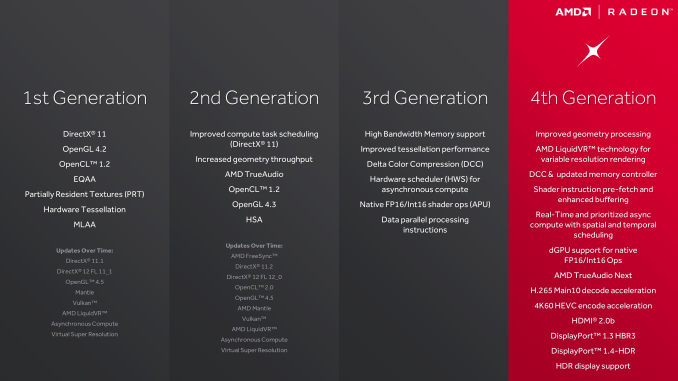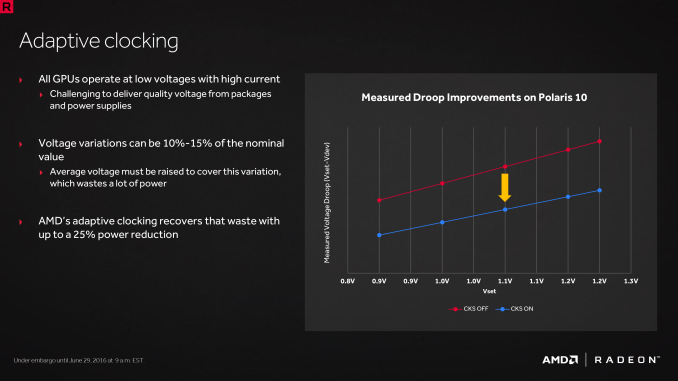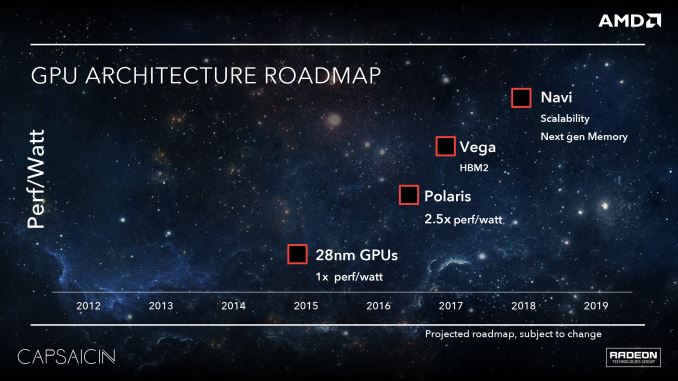The AMD Radeon RX 480 Preview: Polaris Makes Its Mainstream Mark
by Ryan Smith on June 29, 2016 9:00 AM ESTAMD's Path to Polaris
With the benefit of hindsight, I think in reflection that the 28nm generation started out better for AMD than it ended. The first Graphics Core Next card, Radeon HD 7970, had the advantage of launching more than a quarter before NVIDIA’s competing Kepler cards. And while AMD trailed in power efficiency from the start, at least for a time there they could compete for the top spot in the market with products such as the Radeon HD 7970 GHz Edition, before NVIDIA rolled out their largest Kepler GPUs.
However I think where things really went off of the rails for AMD was mid-cycle, in 2014, when NVIDIA unveiled the Maxwell architecture. Kepler was good, but Maxwell was great; NVIDIA further improved their architectural and energy efficiency (at times immensely so), and this put AMD on the back foot for the rest of the generation. AMD had performant parts from the bottom R7 360 right up to the top Fury X, but they were never in a position to catch Maxwell’s efficiency, a quality that proved to resonate with both reviewers and gamers.
The lessons of the 28nm generation were not lost on AMD. Graphics Core Next was a solid architecture and opened the door to AMD in a number of ways, but the Radeon brand does not exist in a vacuum, and it needs to compete with the more successful NVIDIA. At the same time AMD is nothing if not scrappy, and they can surprise us when we least expect it. But sometimes the only way to learn is the hard way, and for AMD I think the latter half of the 28nm generation was for the Radeon Technologies Group learning the hard way.
So what lessons did AMD learn for Polaris? First and foremost, power efficiency matters. It matters quite a lot in fact. Every vendor – be it AMD, Intel, or NVIDIA – will play up their strongest attributes. But power efficiency caught on with consumers, more so than any other “feature” in the 28nm generation. Though its importance in the desktop market is forum argument fodder to this day, power efficiency and overall performance are two sides of the same coin. There are practical limits for how much power can be dissipated in different card form factors, so the greater the efficiency, the greater the performance at a specific form factor. This aspect is even more important in the notebook space, where GPUs are at the mercy of limited cooling and there is a hard ceiling on heat dissipation.
As a result a significant amount of the work that has gone into Polaris has been into improving power efficiency. To be blunt, AMD has to be able to better compete with NVIDIA here, but AMD’s position is more nuanced than simply beating NVIDIA. AMD largely missed the boat on notebooks in the last generation, and they don’t want to repeat their mistakes. At the same time, starting now with an energy efficient architecture means that when they scale up and scale out with bigger and faster chips, they have a solid base to work from, and ultimately, more chances to achieve better performance.
The other lesson AMD learned for Polaris is that market share matters. This is not an end-user problem – AMD’s market share doesn’t change the performance or value of their cards – but we can’t talk about what led to Polaris without addressing it. AMD’s share of the consumer GPU market is about as low as it ever has been; this translates not only into weaker sales, but it undermines AMD’s position as a whole. Consumers are more likely to buy what’s safe, and OEMs aren’t much different, never mind the psychological aspects of the bandwagon effect.
Consequently, with Polaris AMD made the decision to start with the mainstream market and then work up from there, a significant departure from the traditional top-down GPU rollouts. This means developing chips like Polaris 10 and 11 first, targeting mainstream desktops and laptops, and letting the larger enthusiast class GPUs follow. The potential payoff for AMD here is that this is the opposite of what NVIDIA has done, and that means AMD gets to go after the high volume mainstream market first while NVIDIA builds down. Should everything go according to plan, then this gives AMD the opportunity to grow out their market share, and ultimately shore up their business.
As we dive into Polaris, its abilities, and its performance, it’s these two lessons we’ll see crop up time and time again, as these were some of the guiding lessons in Polaris’s design. AMD has taken the lessons of the 28nm generation to heart and have crafted a plan to move forward with the FinFET generation, charting a different, and hopefully more successful path.
Though with this talk of energy efficiency and mainstream GPUs, let’s be clear here: this isn’t AMD’s small die strategy reborn. AMD has already announced their Vega architecture, which will follow up on the work done by Polaris. Though not explicitly stated by AMD, it has been strongly hinted at that these are the higher performance chips that in past generations we’d see AMD launch with first, offering performance features such as HBM2. AMD will have to live with the fact that for the near future they have no shot at the performance crown – and the halo effect that comes with it – but with any luck, it will put AMD in a better position to strike at the high-end market once Vega’s time does come.













449 Comments
View All Comments
TheinsanegamerN - Thursday, June 30, 2016 - link
So it cant to 60FPS constant at 1080p, but it CAN do 90FPS constant at 2160x1200? Did you fail math?Sushisamurai - Friday, July 1, 2016 - link
I think the point of yojimbo's post is that it should be able to hit 90fps @2160x1200 at medium to low settings. It can't hit 60FPS at ultra high settings at 1080pYojimbo - Friday, July 1, 2016 - link
Yes exactly. Ironically, math is my area of expertise.cocochanel - Thursday, June 30, 2016 - link
You must be smarter than the engineers at AMD. They said this card was designed for VR, they would not make such a claim if the card did not deliver. 3-4x higher performance ? Where do you live ?CiccioB - Friday, July 1, 2016 - link
In a world where marketing claims results to be false for most of the times.Wasn't Polaris 10 going to have 2.5x efficiency gain vs GCN? An AMD engineer told that as well. And has even put it on a slide.
I just saw 40% gain. While Pascal gained more than 60% over Maxwell. Which was still 40% better than GCN.
If an AMD engineer tells you that this card can fly, would you accelerate the fan at the level to try that claim? You know, an engineer has told you that it can! And it was an AMD engineer, nothing less!
FriendlyUser - Wednesday, June 29, 2016 - link
Perf/W would be much better if they had used GDDR5X, which they did not, for cost reasons. HBM is even more power efficient. Then you have the board itself, which probably is not as electrically sophisticated as the much more expensive nVidia 1080 board. Finally, you don't know which of the two process technologies is better for perf/W (two different foundries). In the end, I don't think the chip design is the main difference.Yojimbo - Thursday, June 30, 2016 - link
The RX 480's perf/W is really no better than the GTX 970, which uses GDDR 5 RAM like the RX 480 as well as a 28nm process compared with the 14nm process of the RX 480. I do think the architecture is the main difference. Polaris 10's architecture seems to be significantly less efficient than Maxwell's, after accounting for the advantage of the 14nm process of the RX 480. Pascal is even more efficient architecturally than Maxwell.Meteor2 - Wednesday, June 29, 2016 - link
The 1080/1070 take the performance/power crown. But the 480 comfortably takes the performance/price crown. What's interesting is that the 1080 isn't quite fast enough for AAA titles at 4K and the 1070 sits in no man's land, while the 480 runs AAA and 1080p and does VR. It's clear which option is the solid buy.Yojimbo - Thursday, June 30, 2016 - link
Yes the RX 480 will take the performance/price crown assuming supply can keep up with demand, but for how long? The GTX 1060 will be out in a month or two and be very competitive in price/performance.The 1080 is fast enough for AAA titles at 4K if one doesn't max out the settings. A similar thing can be said for the 1070. Also similar is RX 480's VR claim. It can only manage VR gaming when settings are not maxed out. Are you a console gamer or you just have selective memory? This paragraph should be redundant for a PC gamer.
Demibolt - Friday, July 1, 2016 - link
Not here to argue, just fact checking.GTX 970 can be purchased for ~$240 from several online retailers (less if you get a used one from ebay). Given the close performance figures between the 2 cards and the inevitable price-drop that will happen with the GTX 970, It is objectively too soon to say the price/performance benefit of one cards beats out the other.